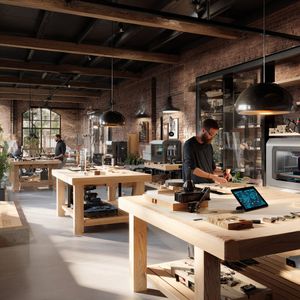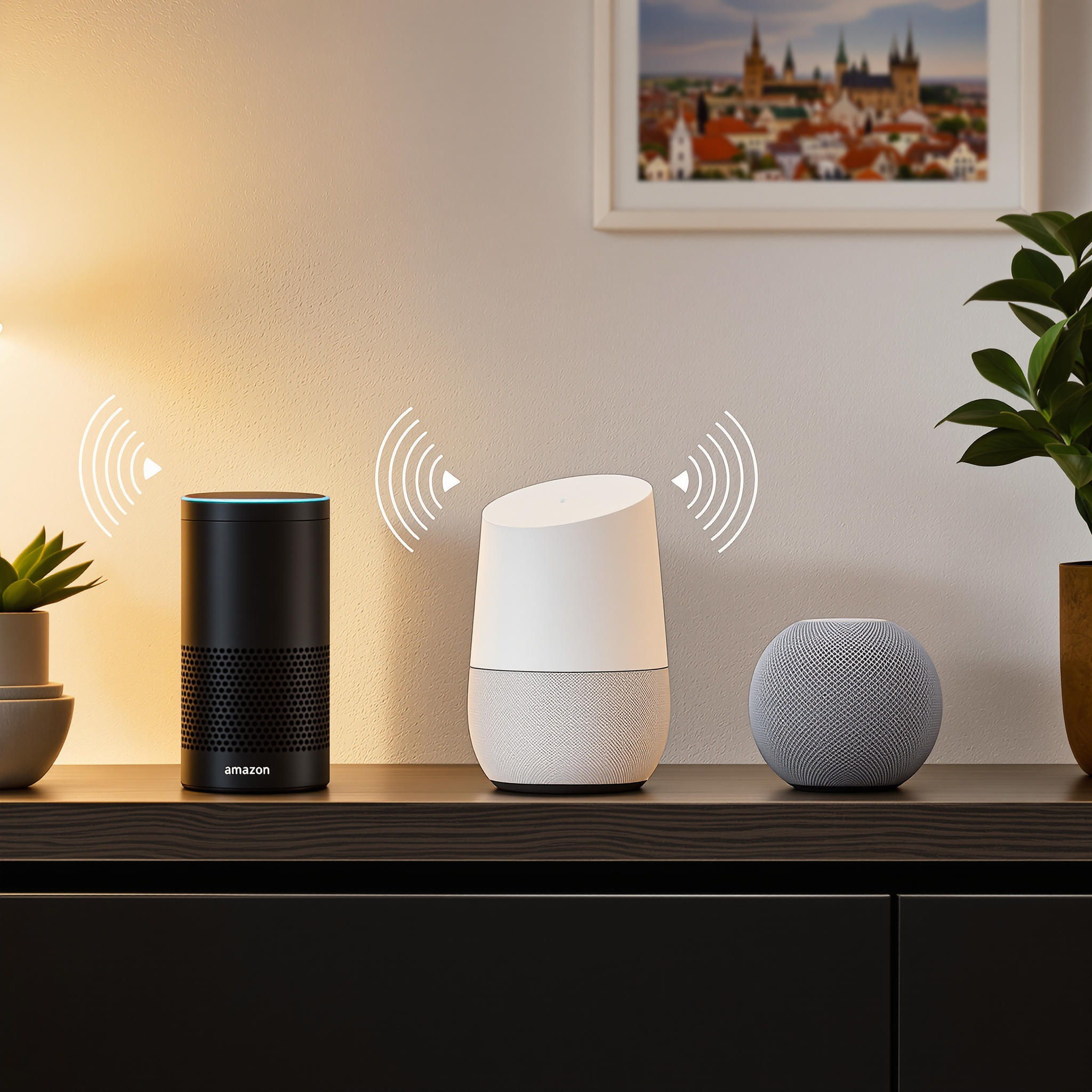The Rise of Smart Workshops: Where Traditional Craftsmanship Meets Digital Innovation

Transform Your Home Into a Smart Paradise - 2025 Guide
Discover the latest smart home technology that will revolutionize your daily routine.
The modern world is witnessing a fascinating renaissance in hands-on creation, driven by the emergence of "smart workshops" – community spaces that seamlessly blend traditional craftsmanship with cutting-edge digital technology. These innovative makerspaces are transforming how we approach DIY projects, learning, and community building.
What Makes a Workshop "Smart"?
A smart workshop goes far beyond the traditional garage or basement workspace. These are carefully designed community hubs that integrate classic woodworking tools with 3D printers, laser cutters with hand saws, and programming stations with pottery wheels. The "smart" element isn't just about the technology – it's about creating an intelligent ecosystem where analog and digital creation methods complement each other.
Key Features of Modern Smart Workshops
Digital Fabrication Tools: 3D printers capable of creating prototypes in various materials, laser cutters for precise engraving and cutting, and CNC machines for automated manufacturing processes.
Traditional Craft Stations: Fully equipped woodworking benches, metalworking areas, textile sections with industrial sewing machines, and specialized zones for activities like leather working and ceramics.
Hybrid Learning Spaces: Areas designed for both hands-on creation and digital learning, often featuring interactive displays and augmented reality systems that can overlay digital instructions onto physical projects.
Sustainable Material Libraries: Collections of recycled and upcycled materials, encouraging members to reimagine waste as valuable resources for new creations.
The Community Revolution
What truly sets smart workshops apart is their focus on community building. Unlike traditional manufacturing or even home workshops, these spaces are designed to foster collaboration, knowledge sharing, and cross-pollination of ideas between different disciplines.
Members often find themselves working alongside software developers learning woodworking, artists exploring electronics, and retired engineers teaching young makers the fundamentals of mechanical design. This diversity creates an environment where innovation flourishes naturally, leading to projects that wouldn't emerge in isolation.
Collaborative Innovation
Traditional Workshop: Individual → Isolated Creation
Smart Workshop: Community → Collaborative Innovation → Shared Learning
The collaborative nature of smart workshops leads to:
- Knowledge Transfer: Skills shared across generations and disciplines
- Resource Optimization: Expensive tools shared among many users
- Innovation Acceleration: Cross-disciplinary problem solving
- Social Impact: Stronger community connections
Educational Impact and Skill Development
Smart workshops are revolutionizing education by offering project-based learning that combines multiple disciplines. A single project might involve:
- Design thinking and problem-solving
- Digital modeling and 3D printing
- Traditional joinery and finishing techniques
- Electronics and programming
- Sustainability considerations and material science
This holistic approach helps learners develop both technical skills and creative problem-solving abilities that are increasingly valuable in our complex, interconnected world.
Learning Pathways
Beginner Track:
- Safety orientation and basic tool familiarity
- Simple hand tool projects
- Introduction to digital design
- Basic 3D printing and laser cutting
- Electronics fundamentals
Intermediate Development:
- Multi-material projects
- Programming and automation
- Advanced fabrication techniques
- Teaching and mentoring others
- Project leadership roles
Expert Specialization:
- Research and development projects
- Community workshop leadership
- Technology integration consulting
- Curriculum development
Accessibility and Democratization of Manufacturing
One of the most significant impacts of smart workshops is making advanced manufacturing tools accessible to individuals who couldn't otherwise afford them. Professional-grade equipment that would cost tens of thousands of dollars for personal ownership becomes available for a modest monthly membership fee.
Economic Impact
Cost Comparison:
Home Workshop Setup: $15,000-50,000
Smart Workshop Membership: $50-150/month
Break-even: 10-30 years vs immediate access
This democratization is particularly powerful for entrepreneurs and inventors who can now prototype and test ideas without significant upfront investment. Many successful startups have emerged from projects that began in community makerspaces.
Success Stories Include:
- Hardware startups prototyping products
- Artists creating custom installations
- Inventors developing medical devices
- Students building competition robots
- Entrepreneurs testing market concepts
Environmental Benefits Through Repair and Upcycling
Smart workshops are playing a crucial role in promoting sustainable consumption patterns. By providing tools and expertise for repair, modification, and upcycling, they help extend the lifespan of products that might otherwise end up in landfills.
Circular Economy Integration
The repair café movement, often integrated into smart workshops, has demonstrated that many "broken" items can be restored to full functionality with the right tools and knowledge. This not only reduces waste but also helps people develop a deeper appreciation for the objects in their lives.
Environmental Impact:
- Waste Reduction: 70% of items brought to repair cafés can be fixed
- Material Reuse: Creative upcycling projects give new life to discarded materials
- Local Production: Reduced shipping and packaging through local making
- Skills Transfer: Knowledge preservation prevents loss of repair skills
Sustainable Practices
Traditional: Buy → Use → Discard
Smart Workshop: Design → Make → Use → Repair → Upcycle → Share
Technology Integration and the Future
The integration of technologies like IoT sensors, AI-assisted design tools, and augmented reality instruction systems is making smart workshops even more powerful. These technologies can:
Current Implementations
Real-time Safety Monitoring: Smart sensors detect unsafe conditions and provide immediate warnings
Personalized Learning: AI systems adapt instruction based on individual progress and learning styles
Remote Collaboration: Video conferencing and shared design platforms connect workshops globally
Resource Optimization: Smart scheduling and inventory management systems maximize equipment utilization
Emerging Technologies
Augmented Reality Training:
- Overlay digital instructions on physical objects
- Real-time guidance for complex procedures
- Safety zone visualization
- Progress tracking and assessment
AI-Powered Design Assistance:
- Automated design optimization
- Material selection recommendations
- Cost and time estimation
- Failure prediction and prevention
IoT Workshop Management:
- Equipment status monitoring
- Predictive maintenance scheduling
- Environmental condition control
- Usage analytics and optimization
Challenges and Considerations
Despite their many benefits, smart workshops face several challenges that must be addressed for sustainable growth:
Safety and Training
The combination of traditional tools and modern technology requires comprehensive safety protocols and training programs. Key considerations include:
- Multi-skill Competency: Users need training in both traditional and digital techniques
- Equipment Complexity: Modern tools require specialized knowledge and maintenance
- Risk Management: Mixing novice and expert users in shared spaces
- Insurance and Liability: Complex coverage needs for diverse activities
Digital Divide
Ensuring that technology enhances rather than intimidates newcomers requires careful attention to user experience design:
- Accessibility: Interfaces that work for all skill levels
- Training Programs: Structured learning paths from basic to advanced
- Mentorship: Pairing experienced users with beginners
- Documentation: Clear, multilingual instructions and resources
Sustainability of Operations
Balancing accessibility with the costs of maintaining expensive equipment and facilities:
Revenue Challenges:
- Equipment depreciation and replacement costs
- Utility expenses for high-power equipment
- Insurance and liability coverage
- Staff training and certification
Solutions:
- Diversified membership models
- Corporate partnerships and sponsorships
- Grant funding for educational programs
- Equipment sharing with other workshops
Community Management
Creating inclusive environments that welcome makers of all backgrounds and skill levels:
- Cultural Sensitivity: Accommodating diverse backgrounds and approaches
- Conflict Resolution: Managing disputes over resources and space
- Knowledge Preservation: Documenting and sharing institutional knowledge
- Leadership Development: Training community members as leaders and mentors
Looking Forward: The Future of Smart Workshops
As smart workshops continue to evolve, we can expect to see even greater integration with emerging technologies and deeper community connections.
Expected Developments (2025-2030)
Virtual Reality Training Systems: Immersive learning environments that allow practice without material waste or safety risks
Advanced Materials Science: Access to smart materials, bio-based composites, and programmable matter
Sustainable Manufacturing: Carbon-neutral workshop operations and closed-loop material systems
Global Collaboration Networks: Real-time project sharing and collaborative making across continents
Disruptive Innovations
Molecular Assembly: Atom-by-atom construction capabilities at the community level
AI Creative Partners: Artificial intelligence that collaborates in the design and making process
Biointegrated Tools: Equipment that responds to user biometrics and health conditions
Self-Organizing Spaces: Workshops that automatically reconfigure based on project needs
Getting Involved: Your Path to Smart Workshop Participation
Finding a Local Smart Workshop
Research Methods:
- Online directories (Makerspace.com, FabLabs.io)
- University and library programs
- Local community centers
- Meetup groups and maker communities
What to Look For:
- Equipment variety and quality
- Community culture and inclusivity
- Training and educational programs
- Safety protocols and procedures
- Membership costs and benefits
Starting Your Own Smart Workshop
Planning Considerations:
- Community Assessment: Understand local needs and interests
- Space Requirements: Ventilation, power, safety, accessibility
- Equipment Selection: Balance cost, versatility, and maintenance
- Legal Structure: Nonprofit, for-profit, or cooperative models
- Funding Strategy: Grants, membership, partnerships, donations
Implementation Steps:
- Build a founding team with diverse skills
- Develop a business plan and budget
- Secure initial funding and space
- Purchase essential equipment
- Establish safety protocols and training
- Launch with community events and classes
Maximizing Your Smart Workshop Experience
Preparation:
- Complete all required safety training
- Start with simple projects to build confidence
- Connect with other members and ask questions
- Respect shared resources and clean up after use
Growth Opportunities:
- Volunteer for workshop maintenance and training
- Propose new classes or equipment purchases
- Collaborate on community projects
- Share your expertise with newer members
Conclusion: The Future of Making
The rise of smart workshops represents more than just a trend in making and crafting – it's a fundamental shift toward more collaborative, sustainable, and innovative approaches to creation. As these spaces continue to grow and evolve, they're not just changing how we make things; they're changing how we learn, collaborate, and solve problems together.
Smart workshops are democratizing access to advanced manufacturing tools, fostering cross-disciplinary innovation, and building stronger communities around shared creation. They're proving that the future of manufacturing isn't just about automation and efficiency – it's about human creativity, community connection, and sustainable practices.
For anyone interested in hands-on creation, learning new skills, or simply being part of a creative community, smart workshops offer an unprecedented opportunity to explore the intersection of traditional craftsmanship and digital innovation. The future of making is here, and it's smarter, more collaborative, and more accessible than ever before.
Key Takeaways:
- Smart workshops blend traditional and digital making methods
- Community collaboration drives innovation and learning
- Accessibility democratizes advanced manufacturing capabilities
- Sustainability practices reduce waste and environmental impact
- Future growth depends on addressing challenges around safety, inclusion, and operational sustainability
The smart workshop movement is still in its early stages, with tremendous potential for growth and impact. Whether you're a seasoned maker or just starting your creative journey, there's never been a better time to explore what these innovative spaces have to offer.
Smart Home Upgrade Package 2025
Transform your home with the latest smart technology
Transform Your Home Into a Smart Paradise - 2025 Guide
Discover the latest smart home technology that will revolutionize your daily routine.

